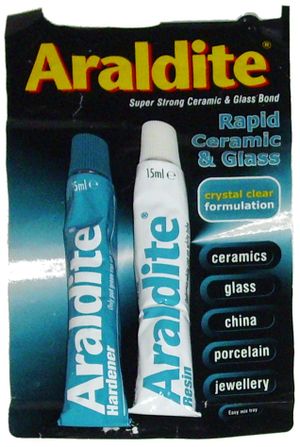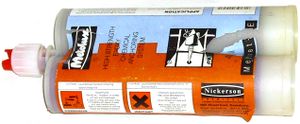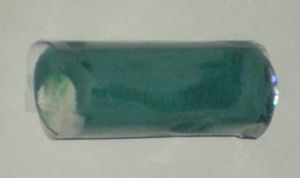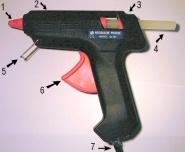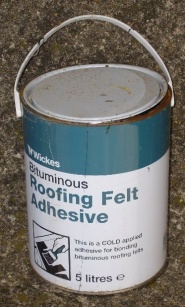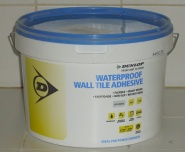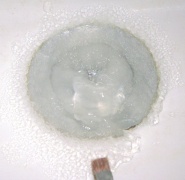Difference between revisions of "Adhesive"
Mapsupplies (talk | contribs) |
(→Polyurethane: pic) |
||
| (4 intermediate revisions by 2 users not shown) | |||
| Line 23: | Line 23: | ||
==Epoxy Resin== | ==Epoxy Resin== | ||
| − | [[image:Clear epoxy | + | [[image:Clear epoxy 0067-6.jpg|thumb|Clear epoxy resin]] |
[[image:Epoxy 0070-4.jpg|thumb|Epoxy resin]] | [[image:Epoxy 0070-4.jpg|thumb|Epoxy resin]] | ||
[[image:epoxy_putty_1647-2.jpg|thumb|Epoxy putty]] | [[image:epoxy_putty_1647-2.jpg|thumb|Epoxy putty]] | ||
| Line 77: | Line 77: | ||
* Exterior grade PVAs available, but are not waterproof | * Exterior grade PVAs available, but are not waterproof | ||
* Not suitable for woodwork where failure could cause injury, eg chairs, beds ets. | * Not suitable for woodwork where failure could cause injury, eg chairs, beds ets. | ||
| + | * [https://groups.google.com/group/uk.d-i-y/browse_frm/thread/2464c8abd971d4b0?hl=en# Brands of PVA] | ||
==Acrylic sealant== | ==Acrylic sealant== | ||
| Line 106: | Line 107: | ||
==Polyurethane== | ==Polyurethane== | ||
| − | [[image:PU adhesive | + | [[image:PU adhesive 0571-5.jpg|right|185px]] |
* Exterior & interior use | * Exterior & interior use | ||
* Sticks well to wood, metals & masonry | * Sticks well to wood, metals & masonry | ||
| Line 327: | Line 328: | ||
* car accessory shops | * car accessory shops | ||
* http://www.cfsnet.co.uk/ | * http://www.cfsnet.co.uk/ | ||
| − | [http://www.gorillaglueonline.co.uk GorillaGlueOnline.co.uk] | + | * [http://www.gorillaglueonline.co.uk GorillaGlueOnline.co.uk] |
=See Also= | =See Also= | ||
| Line 346: | Line 347: | ||
[[Category:Wood]] | [[Category:Wood]] | ||
[[Category:Repair]] | [[Category:Repair]] | ||
| + | [[Category:Basics]] | ||
| + | [[Category:Fixings]] | ||
Latest revision as of 19:46, 30 April 2012
Adhesives By Type
Cyanoacrylate
- aka superglue, crazy glue
- CA (cyanoacrylate) is famous for accidentally gluing skin together
- debonders available to unstick skin,
- cyanoacrylacte activators are available to speed up setting to 2 or 3 seconds, but these reduce final strength.
- For non-porous surfaces.
- Its low shear strength enables it to be used as a removable glue in some cases, eg for mounting items to a block on a lathe.
- can be used as a thread lock
- Cyanoacrylates are used to glue human and animal tissue after accidents. The medical grade is a slightly different formula with improved medical properties, but standard superglue also works and was previously used medically.
- CA is also effective at stoping bleeding at trauma sites.
- When added to baking soda (Sodium bicarbonate) Cyanoacrylate glue forms a hard, lightweight filler/adhesive (baking soda is first used to fill a gap then the adhesive is dripped into the baking soda). This works well with porous materials that the glue doesn't work well with alone.
- Thin CA is occasionally used as a tough glossy wood varnish for small items such as turned pens.
- Moisture triggers setting
- Opened bottles keep longer if stored in a container with a desiccant (eg silica gel)
- Cured CA can be removed with acetone or methylene chloride.
- A few hours in the freezer can make it brittle
- Accidetal gluing of eyes is a real risk with CA
- Very low flash point
Epoxy Resin
- Araldite is a well known epoxy resin formulation
- 2 part resin
- Available as liquid resin tubes, putty sticks, or in 400ml cartridges with self mixing nozzles.
- cartridges are used with a self mixing nozzle, which is replaced after each use
- Epoxies come mixed with many different fillers and modifiers, giving them a range of properties
- Epoxy formulations may be runny, gel, paste or putty, each best suited to its own uses.
- Tough
- Good chemical resistance.
- Car accessory shops sell tougher epoxies than Araldite.
- The quick setting types are much weaker
- Vulnerable to UV, which causes degradation.
- Heating the mix (in tinfoil on a low ring, or over boiling water) until runny makes it set very much faster. Don't overheat it.
- Some formulations are heat resistant, some not. The ones that aren't may claim they are on the basis that they survive heat, even if they do lose all strength when hot.
- Heat while setting makes it more heat and chemical resistant once set.
- More strength and cost than polyester or vinylester resins.
- Epoxies are used as powder coatings (a tough paint-like finish)
- Very good electrical insulation (once cured), good for EHT insulation repairs.
- Metal loaded epoxies can be conductive
- Suitable for work where failure could cause injury, eg chairs, fixing heavy loads to walls, structural repairs to wood & masonry, etc.
- Suitable for wood, metal, glass, stone, and some plastics.
- Vinegar will clean up uncured and semi-cured epoxy, but not once cured.
- 1:1 resin to hardener ratio typical, but ratios of upto 5:1 are also available.
See also:
Hot-melt glue
- Almost instant setting
- Handy for creating structures where glue needs to set at each stage before the next can be glued
- Not a strong durable glue
- Most common hot melt glue stick chemistry is amorphous polypropylene plus tackifiers and fillers. Several other chemistries also exist.
- Polyethylene requires temperatures above those of standard retail glue guns to work, if you put polythene in an ordinary glue gun it will just soften enough to block it.
- Low melting point glues and guns are also available. Often used by kids due to nearly instant setting and less burn risk.
PVA
PVA has a wide range of uses in building and DIY.
- There are White and yellow types of PVA
- A good general purpose wood glue
- Reduces permeability of cement mortar & increases adhesion
- Use as a plaster size
- softens when wet
- Exterior grade PVAs available, but are not waterproof
- Not suitable for woodwork where failure could cause injury, eg chairs, beds ets.
- Brands of PVA
Acrylic sealant
- A cheap replacement for silicone
- tends to turn to cottage cheese if it stays wet
Caulk
- Caulk is a low cost slightly flexible acrylic formula used for filling
- Paintable
No more nails
- Water based
- Acrylic adhesive with filler
- Solvent free
- High grab
- Designed to replace nails for some jobs
- e.g. solvent-free Gripfill, No-more-nails etc
Solvent based building adhesives
(Gripfill etc)
? type
"Sticks like SH!T" etc
Polyurethane
- Exterior & interior use
- Sticks well to wood, metals & masonry
- Fully waterproof as long as it gets to dry out regularly
- Turns to goo if it stays wet for a month
- Adhesive activated/set by damp
- Foams slightly to fill small gaps, but this foamed adhesive has very little strength, so in practice its not good for gap filling applications
- Paintable
- One surface should be porous
- Clamp while setting
- Slight dampening of one surface helps to maximise final joint strength.
- Remove glue with acetone before fully set, or a chisel or knife once set.
Polyester resin
- tough
- sticks a wide range of materials
- used in fibreglass work
- used to fill damaged exterior woodwork, eg sash windows
- available in clear or colours
- car body filler is polyester resin
- All resin glues contain various fillers to reduce cost and modify their properties.
- 10:1 resin to hardener ratio is typical
- ideal for filling rusted metal windows
See also:
Vinylester Resin
- Stronger than polyester resin, not as strong as epoxy resin
- contains styrene
Silicone
- Silicone Sealant is a satisfactory glue in shear, but has little strength in tension.
- Silicone is used to glue glass aquaria together, but this is a tougher formula than builders' silicone sealant.
- Building silicones are RTV, room temperature vulcanised.
- There are several types of silicone
- For more information see Silicone Sealant
Plastic cement
Solvent based plastic cements are plastics dissolved in a solvent. These cements, and solvents alone, are used to glue soluble plastics.
- acrylic (perspex) in acetone is used to glue acrylic (perspex).
- Solvent weld is used to glue PVC pipe and trunking
Latex
- Flexible when dry
- Repairs carpet cuts & frays
- used for carpet patching
- not tough
- occasionally used to glue clothes, eg trouser turnups
Bitumen adhesives
- Roofing adhesives are primarily bitumen & petrochemical solvent
- Let it go tacky before applying the roofing felt, so it holds the felt down
- may be thinned / dissolved with various petrochemical solvents
There are 3 types of Bitumen adhesive:
- Solid bitumen, which is heated to melt it
- Bitumen in solvent, as pictured. Solvents include naphtha, white spirit, or even paraffin
- Bitumen emulsion. This is bitumen dispersed in water, and is usually acidic.
Tile adhesives
- Most are modified cement or glue formulae
- Ready mixed cement types contain a set preventer that evaporates on use.
- See BAL Adhesives guide for information on different types
- Waterproof ones only survive if they dry out regularly.
- Swimming pool types are required where they will stay wet.
Wallpaper Paste
- Starch modified to disperse in cold water, sometimes with added pva
- other chemistries have also been used, such as cellulose and starch
- Dries clear
- Water soluble
- Contains mould inhibitor
Starch
- Glue for wallpaper, card & paper.
- To make starch glue, boil some starch (eg flour, oats, etc) in water until it changes from white to semi-clear. Add a little alum to prevent mould if you're not using it immediately.
- To make a starch gluestick, parboil a potato. Suitable for gluing paper, just wipe with the potato and press together. Will not store.
- Low cost, complete safety and easy to wash out; ideal for kids
- Old black wallpaper adhesive is starch; the starch mouldered before drying out.
Rubber cement
- Rubbery plastic in solvent
- for gluing rubbery plastics, mainly bike tyres & inner tubes & inflatable furniture
- non vulcanising, so not as tough as vulcanised rubber
- not tough enough for shoes
- eg Platignum studio gum
- Risks
Adhesives By Purpose
Wood
- PVA
- Animal
- Resin
- Polyurethane
- Acrylic
- Epoxy
see Wood glues
Metal
- Epoxy
- Polyurethane
- Contact
Plastics - PVC, ABS
- Plastic welding solvents form the strongest bonds by far
- plastic cement
Plastics - hard
- Epoxy
- Polyurethane
- ...
Plastics - polyethylene, nylon
- It has long been accepted that no glue can effectively stick these directly, however one now claims to: Loctite Plastix advanced plastic bonder
- A weak bond can be achieved with evostick contact adhesive
- Flamed polythene and nylon can be glued
- Melting the surfaces together also works, if both materials being joined are the same substance. Local heating can be achieved on flared circular joints by spinning while applying pressure.
Fabric
- Latex, eg Copydex
- Water based starch glues are good for temporary gluing, eg while sewing. They wash out later.
- Its also possible to melt plastic to bond fabrics together. This is often used for trouser turnups, film plastic is positioned and the fabric sandwich ironed on hot.
Paper & Card
- PVA
- Gum
- Glue sticks (eg Pritt-stick) (PVA or PVP)
- Spray-type photo fixing etc
- Wallpaper paste
- Starch
Oil lines
- Red hermetite
Plaster
to consolidate & stabilise loose plaster:
- very dilute PVA (allows it to soak in further)
- limewash
- Loose plaster may also be drilled and dilute pva poured in to rebond it to the wall
- L&P ceilings may have dilute pva poured on from above to re-attach them to the laths. Sagged patches can be propped back into place first if the damage is only localised.
Adhesive Selector Grid
Which adhesive is best for any 2 given materials?
Structural Adhesives
Structural adhesives or engineering adhesives are used where failure could cause injury or other undesired consequences. These high strength & higher reliability adhesives include:
- epoxy
- polyurethane
- acrylic
- cyanoacrylate
Preparation
In the great majority of cases, to obtain a good bond surfaces should be prepared so they are:
- clean
- dry
- loose or flaky material removed
- degreased
Roughening smooth surfaces increases the adhesive bond strength, and in many cases is necessary to obtain sufficient strength.
Moulding tools
Sometimes adhesives need to be moulded.
Fugee & Fugenboy
Shaped polypropylene tools to achieve a nicely shaped seal around baths etc.
Polythene
Adhesives don't stick to polythene, and its readily available as polythene film (eg binbags, dust sheet, rubble bags). Can be used under adhesive to obtain a flat smooth underside, or gently brushed onto the top of wet adhesive to get a smooth flat (or curved) finish.
PTFE
As polythene but much more flexible.
Wood
Wooden tools may be used on silicone if kept wetted with 50/50 washing up liquid & water. Wooden kitchen implements are often to hand.
Fillers
Fillers are low cost dry powders used in a lot of adhesives. They reduce cost and in some cases can improve strength. They also affect the adhesive properties to some extent.
Additional fillers can be mixed into adhesives to reduce cost further. Each type of filler will have effects on the glue formulation. Adding fillers does reduce final strength in most cases, but fibrous fillers can sometimes increase it.
2 part adhesives should always be fully mixed before adding fillers. Bond strength may be maximised by using a very thin layer of fillerless adhesive on each substrate before applying filled adhesive to fill the gap.
Common fillers:
- Dry powders such as talc and iron oxide are often used to extend adhesives, but weaken the final result.
- Colloidal silica is used to thicken (gel)
- Sand is very tough, and can be mixed into resins, which bond to it well. This reduces cost, but the resulting mix is not toolable / sandable.
- Sawdust consists of lots of short fibres, and thus can act as reinforcement as well as a bulk filler. It is rather less hard than most glues, but will strengthen some. Its also lumpy.
- milled wood fibres - much improved performance compared to sawdust
- Glass microbeads for bulk
- Carbon or graphite, for some electrical conduction
- Silver - electrical & thermal conduction, but resistance rises as the metal oxidises, and reliability is often a problem, so not recommended for electrical purposes.
Fillers should not be added to adhesive sand compounds such as Geotex, which is used to fill gaps in block paving work, as this generally results in failure. Such products aren't cheap and are already thinned as far as they can be. The addition of sand is a common cause of failure.
Suppliers
- Builder's merchants
- diy sheds
- car accessory shops
- http://www.cfsnet.co.uk/
- GorillaGlueOnline.co.uk
See Also
- West system epoxy manual
- PVA
- Book: 'On boat construction' by Gougeon Brothers is an expert guide to use of epoxies.
- For a general and scholarly article about Adhesives see Wikipedia
- BAL Adhesives tables
- Glue Terminology
- Low cost homemade adhesives
- The Burn test for gluing plastics
- Wiki Contents
- Wiki Subject Categories

